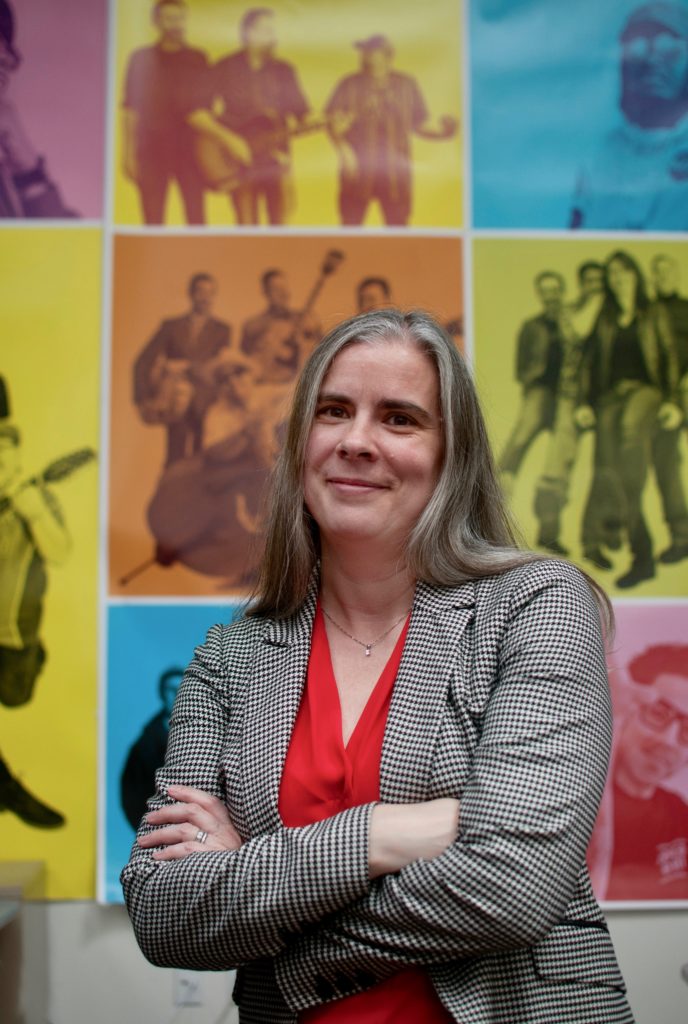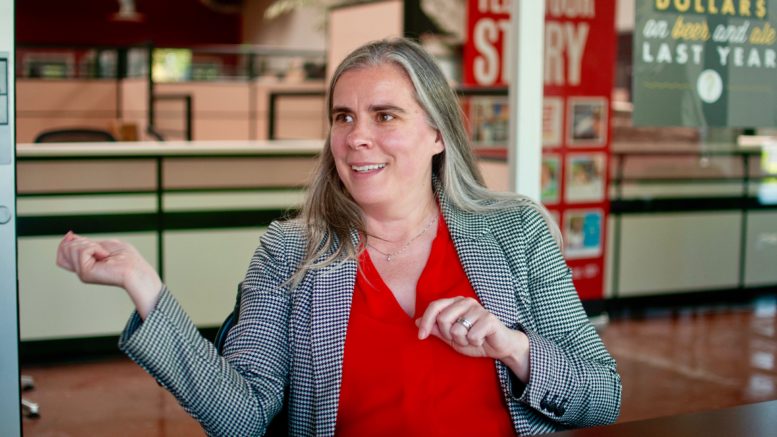How will Sacramento’s arts community rebound after the pandemic? Among those navigating the comeback is Megan Van Voorhis, the City of Sacramento’s Cultural and Creative Economy Manager. Following a national search, Megan started her new job in September 2020 – just as California was reentering a COVID-related lockdown. She previously had been the leader of Arts Cleveland, which could be a model for Sacramento success.
Recently, Megan sat down with News & Review publisher Jeff vonKaenel to discuss her vision for Sacramento arts.

Jeff: I wanted you to share your vision of what’s happening, because I think a lot of people would be very interested. And a lot of people are wondering, “Now what?” Theaters and concert venues have been dark for a year; how are they going to put things back together? What is the city going to be doing to try to help that process? And how can we all work together to do that? Over the last several years, the City of Sacramento has been really rethinking its role in the arts community and the creative community and how they’ll fund different kinds of arts. So, can you tell us a little about your position?
Megan: So, my title is Cultural and Creative Economy Manager. And I usually just tell people to say “creative economy manager” for short, because the arts and cultural sector is part of that.
My role is that I am the division manager that leads the Office of Arts and Culture (which) includes film, arts education, grants, and public art. That’s how we’ve traditionally been known. About (January 2020), we stopped being a joint entity of the City and the County, which was previously Sacramento Metropolitan Arts Commission, and we became this sole division of the City. Just because we restructured doesn’t mean we don’t have a partnership or relationship with the county. I actually think that’s really important given the work that we do. …
I come with a long history of advocacy and research and data in the arts, so for me — the first step, or first part of the process — was really defining, moving forward, what is going to be the role of our office, or our division of the City, in advancing?
We’ve identified five core functions that we’re going to perform. One is information — helping people, providing information that helps people make decisions regarding their engagement in the arts, whether that’s going to be finding an event to attend, or understanding what the role of the arts is in relationship to healthcare, neighborhoods, etc. It’s providing information that helps them make decisions. …
I’ll give you all five: Information; workforce development; investment; convenient coordination —working with people, both inside and outside of government, philanthropy etc.; and law, legislation and policy.
Arts education, for example, is an area where we want to focus. We want to provide information that helps people make decisions around arts education. So for example, here’s where all of the arts and cultural arts education activity is happening. And here are the gaps. And so we’re going to focus here, to improve access and equity.
Jeff: Part of the concern previously was the City’s funding and the County’s funding for arts mainly — disproportionately over the years — went to a relatively small number of arts organizations. And so part of the goal was then to really rethink “arts for Sacramento,” and then to be much broader and reflect the diversity of the arts organizations. And then to tie in more to economic development. …
Megan: If you say, “arts and cultural organizations,” it has a specific connotation for people. It might be a theater company or a dance company, or it might be a museum or something like that. Those are some of the traditional definitions.
Artists, what is that? When you apply a creative economy lens to it, you recognize that … there are creative people working in every industry. What are we doing occupationally to advance everything from design occupations to animation … to composition, to photography, all of those things? … The foundation of the creative sector, or creative industries, is really in the creative talent base. Recognizing that, understanding what our strengths are, and really feeling and supporting that creation of pathways to opportunity. … How are we passing people to those opportunities from an equity perspective?
And that, for me, was super exciting about this opportunity. Because for years and years in Cleveland, I was advocating on behalf of folks and trying to get economic development professionals and others to see the advantages of investing in creative industries, because I actually think it’s foundational to an innovation economy.
Now, I’m actually in a position in the conversation with people who are saying “We’re trying to grow an economy,” and I can say, OK — here!
Jeff: What are some of the insights you had from your Cleveland experience and how do they apply to the current challenge in Sacramento right now?
Megan: If I look at Sacramento, it’s almost where Cleveland was when I started (in 2003). … The (creative) sector, just generally, was really under-resourced. There was a lot of division in the field, people feeling undervalued. It was small versus large, this kind of organization versus that kind of organization. That’s where they were at the time.
We did a lot of work to try to help people understand, come together, and really look at what is it going to take to advance a cause of a place that is supportive of the creative community? So there was a lot of data work that was done, to help people understand what is the value and the impact of this here? What is the urgency? Why is it important for us to do this now? Why can’t we just wait? …
Once we got dedicated funding streams, and people were adequately supported and we started to see money go out through projects at the neighborhood level, and we saw money go to artists, and we saw, operating support go to arts and cultural organizations, now all of a sudden, those groups were able to dramatically rethink what their role was in the community. If your house is on fire, it’s hard for you to think about how you can contribute in these other other ways? Stability in the infrastructure is really important to advancing some of the other things we want to do. …
I bring a lot of that (experience) to this conversation, which is different, because I grew in that (Cleveland) role, learning all of those things. Now when I’m in conversation with economic development professionals, or planning professionals or whatnot, I’m using their language. I’m like a translator.
That’s my job. It’s to understand the contributions that this group of people bring, what these people are trying to do, and link it up. If these people are supported in this way, they can realize these things here. If you take away this barrier here, we can actually create this activity here. So that’s the job.
Jeff: The job — given the complexity and the ecosystem — is to play an active role in helping the ecosystem be more effective to accomplish the multi-sector goals that you have in terms of funding infrastructure, workforce development, etc.
Megan: The job is creative vitality, right? We’re trying to ensure creative vitality. Well, that means I’m concerned with the climate for creative vitality. That means how tough is it for people to get permits? What barriers exist to actually functionally operate in the city?
Jeff: In your tenure in Cleveland, what would be some of the things you’re most proud of?
Megan: Looking back, it’s helping people understand the changing perceptions of the value of what arts and culture and creativity brings. Helping people shape their understanding; that it wasn’t just an afterthought, that we actually saw the creative sector as the fundamental vehicle for which we were trying to make change. … The way to actually increase the wealth in the community is by centering our investment in creativity, because that can help inform our mental health, social cohesion, innovation, our economy, our neighborhoods. That’s why we do it.
Jeff: So a big part of the funding is for youth art, right? Youth programs?
Megan: The signature program that we’ve been involved with over time is Any Given Child, where we’re we’re actively working to bring arts activities to schools that need them. And I think that our partnership on that is likely to shift so that we can play a different kind of role. There’s a project that we’re doing, it’s modeled off of a project that was done in Chicago, Ingenuity, and it basically over a 10 year period dramatically changed access to arts education in the Chicago public schools. So it’s … actually shifting the role so that we can focus on the systems level stuff, and also be working on how do we elevate practice in the field of artists and arts and cultural organizations that are doing a lot of these programs inside, looking at the out-of-school landscape, which is a big area of opportunity and looking at workforce. So the idea of … pivoting one program away from that to look at the systems level and begin to think about workforce and say, we think the economic opportunity is here in the creative industries, and we’re going to try to grow that particular economic opportunity. But we want to make sure that when we’re doing that, that these kids are prepared to benefit from the economic opportunity we’re creating.
Jeff: When you say “economic opportunity,” do you mean where people can get jobs in the arts, or that the arts can create workforce recruitment? Or that the experience in working in the arts makes a better employee?
Megan: I think it’s all of those things. It does all of those things. … People (say), “we want to have an innovation economy.” What does that mean? How do businesses get built? In the arts, we teach the skills that make that possible; prototyping, iteration, those things that are often happening in terms of design processes. We teach those when you write a poem, when you compose a song, when you are creating a piece, when you’re photographing; you create, and you iterate, you create and you iterate. That set of skills is the same set of skills when we’re talking about designing a business or identifying opportunity.
That is why it matters. It matters because, from an economic perspective, that kids have access to the arts, it matters because (the arts) make them better whole human beings. It can unlock certain things (such as overcoming trauma and recovery from isolation). For me, it’s about creating whole humans (and) creating people that are prepared to innovate inside any business, whether you’re in the arts or not. (Then) identifying, “Hey, where are the jobs going? Like what’s happening?”
So, I think animation is a real area of opportunity for Sacramento.
Jeff: Almost all the arts organizations we work with have been dark for a year. It’s not clear how people are going to come back. It’s not clear what the situation is. What are your thoughts on the rebooting? What is the current situation?
Megan: It’s important to note that, when you look at the creative industries overall, they haven’t all experienced the pandemic in the same way. …
But the live experiences … that form a pretty significant part of Sacramento’s arts and entertainment, though it’s a smaller segment of the creative industries — arts, entertainment, recreation, that’s where our independent artists, our museums, our music clubs, our promoters, and everyone in the supply chain for that – has been incredibly affected. First to close, last to open; we know they’ll be last to open. And even though we’re getting guidelines now, around reopening, those guidelines are putting capacities at like 25% for a smaller (venue). That doesn’t work economically. Those are the realities.
Cost of production, particularly for performing arts, is the same, no matter how many people are in that room. If you’re asking us to operate at 25% capacity, … it’s better to stay closed until we can (fully) open and that’s what a lot of folks are facing. …
And then there’s also the question of whether or not people are ready to come back. People are going to feel most comfortable coming back to performing arts events when vaccination is the thing.
I think there is an appetite (for live arts and entertainment), people are craving it. People want it for their kids. I know that I do. I want to be away from a screen, I want my kids to be away from a screen.
There are multiple layers here; one, which is very practical, (is) a lot of artists have been put out of work. About half the workforce is independent workers. … When all those (organizations) scaled down, a lot of those opportunities went away.
And let’s also be mindful of the fact that a lot of those folks don’t have safety nets, because of the way that the field is structured. So you have that whole layer of things. Plus then the other side of it, which is the economic realities for the live events industry.
We talk about the venues themselves, but we don’t think about how the venues drive so many other things. So whether it’s advertising in publications, or all of the crews who support the venues … all of those people out of work. (When the pandemic started), we weren’t thinking about the supply chain of people that rely on those venues. … And the independent venues, folks like Harlows and Cafe Colonial and the Torch Club, are often the sources, the vehicles for local talent. They’re the ones that are cultivating the local talent.
Jeff: Do you think that a lot of our arts infrastructure is going to be gone? Or do you think most people are going to be able to reboot?
Megan: Yes, some are going to go. This is one of the reasons why I actually am a huge supporter of funding and supporting artists and creatives, because as long as the talent base is there, you have the opportunity to rebuild.
What I’ve seen in the creative businesses here is that they’re working really hard. Many of them scaled down to survive. I think they’re also being super careful about when they decide they’re going to open up. Because this is not a circumstance where you can open and close. Open and close is the difference between life and death. They’re taking their time. And I think it does make sense. So even if people do want to come out, if the economic realities don’t support it at a certain level, it’s wiser for them to take their time.
Jeff: There are people like me, who want to go do things and then there are places that want to open up but can’t open up unless they have enough people to make it profitable? How do we make this dating service work?
Megan: I’m gonna be honest; I’m not sure yet. I don’t think anybody has ever seen this. Compromise is going to be important. Like, maybe this is going to cost a little more than what you paid before to be able to attend something.
COVID is still here. We need to manage for (safety). And there’s a lot of work to do that. I think that we will see creativity happen. And that’s the cool thing about our sector. You know, there’s a lot of creative things that people are doing.
Jeff: For people who want to help the arts, and reboot, and want to live in a community with a very vibrant art scene, how can they help you do your work here?
Megan: They can start by recognizing and appreciating what they have. I think a lot of people actually probably do at this moment think, wow, it’s just really nice to be able to go out and do these things and I really want to be able to do that. There are opportunities. Organizations need support and there are vehicles for it. That’s one way to be able to engage. Big Day of Giving is coming up. It’s a great opportunity to show how much people value the creative sector here.
Here’s another way people can help. It is recognizing that creative workers have something to bring in every context. We should be putting creatives back to work. And we should recognize that there’s a lot of value in that. So when you’re trying to think about how are you engaging youth in a time when most of them have been remote for a year, and they’re struggling, mentally, investing resources to allow for putting creatives to work, to engage those youth is a good investment. When we think about older adults living in isolation, who haven’t been able to get out at all, or living in areas where they can’t, this is an opportunity to engage creatives to improve the quality of life of those people. We can employ creatives to solve these these problems.
Jeff: What a time to be able to do this.
Megan: You can actually create stuff here. And I’m just hoping to be able to enable more of that here, for the people who are here, which means having creatives be able to afford to live here and continue to create here and live a good quality of life here that can influence the quality of life of others.






Be the first to comment on "The new Sacramento Arts Czar on rebooting the city’s creative economy post-pandemic"